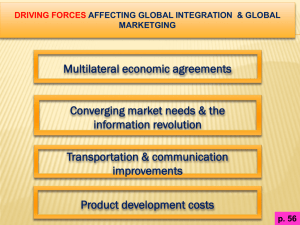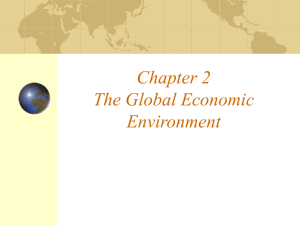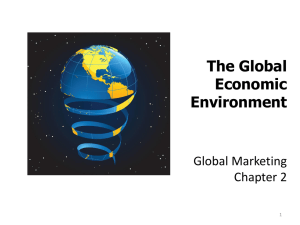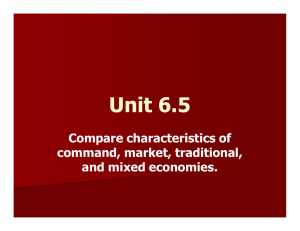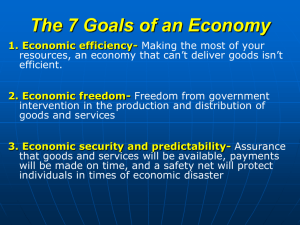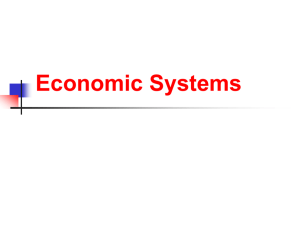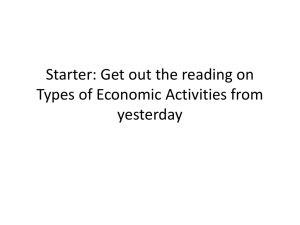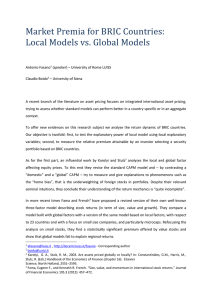Class-2 - Surej P John
advertisement
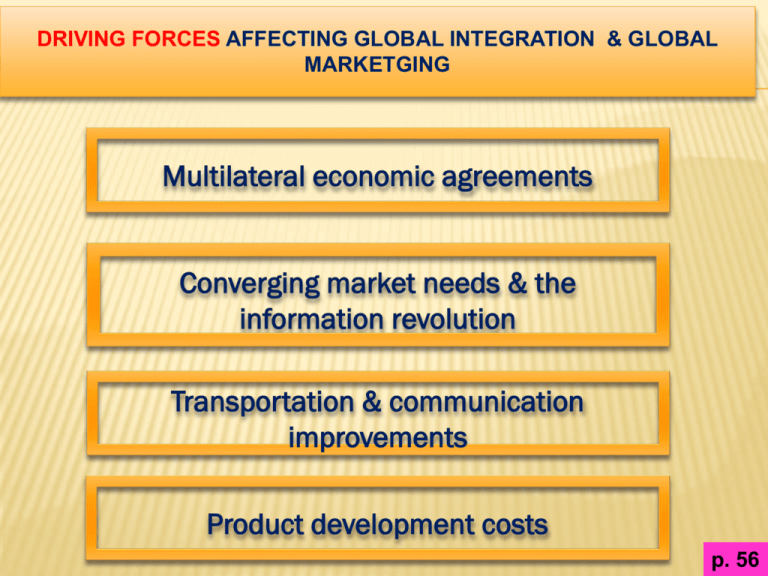
DRIVING FORCES AFFECTING GLOBAL INTEGRATION & GLOBAL MARKETGING Multilateral economic agreements Converging market needs & the information revolution Transportation & communication improvements Product development costs p. 56 DRIVING FORCES AFFECTING GLOBAL INTEGRATION & GLOBAL MARKETGING Quality World economic trends Leverage p. 59 Multilateral Agreements NAFTA The North American Free Trade Agreement or NAFTA is an agreement signed by the governments of Canada, Mexico, and the United States, creating a trilateral trade bloc in North America. The agreement came into force on January 1, 1994. In terms of combined GDP of its members, as of 2010, the trade bloc is the largest in the world. ASEAN The Association of Southeast Asian Nations, commonly abbreviated ASEAN is a geo-political and economic organization of ten countries located in Southeast Asia, which was formed on 8 August 1967 by Indonesia, Malaysia, the Philippines, Singapore and Thailand. Since then, membership has expanded to include Brunei, Burma (Myanmar), Cambodia, Laos, and Vietnam. Its aims include the acceleration of economic growth, social progress, cultural development among its members, the protection of the peace and stability of the region, and to provide opportunities for member countries to discuss differences peacefully. ASEAN- Other Countries ASEAN has concluded free trade agreements with PR China, Korea, Japan, Australia, New Zealand and most recently India. The agreement with People's Republic of China created the ASEAN–China Free Trade Area (ACFTA), which went into full effect on January 1, 2010. In addition, ASEAN is currently negotiating a free trade agreement with the European Union. Converging market needs & the information revolution Information revolution Transportation & Communication improvements Product development costs Cost of developing a new drug in 1976- $54M Cost of developing a new drug in 2009-$400 Million Such huge investments can be recovered only in global market place. Refer Table 1-10 on Page 58 Quality Global marketing strategies generate greater opportunities and greater revenue which intern support design and manufacturing quality. World Economic Trends Leverage Global companies possess the unique opportunities to develop leverage. It means the type of advantage that a company enjoys by virtue of the fact that it has experience in more than one country. Experience transfer Scale of Economies Resource Allocation Global strategy Leverage: Experience Transfers A global company can leverage its experience in any market in the world. It can draw on management practices, strategies, products, advertising appeals, or sales or promotional ideas that have been tested in actual markets and apply them in other comparable markets. ABB- 1400 subsidiaries in 140 countries. Very famous for running the operations with the minimum number of staff Leverage: Scale of Economies The global company can take advantage of its greater manufacturing volume to obtain traditional scale advantages within a single factory. Also, finished products can be produced by combining components manufactured in scale-efficient plants in different countries. The larger scale of the global company also creates opportunities to improve corporate staff competence and quality. Leverage : Resource Allocation A major strength of the global company is its ability to scan the entire world to identify people, money, and raw materials that will enable it to compete most effectively in world markets. Global companies utilizes the resources where there is the greatest opportunity to serve a need at a profit Leverage Global strategy. • The global company's greatest single advantage can be its global strategy. RESTRAINING FORCES AFFECTING GLOBAL INTEGRATION & GLOBAL MARKETGING Management myopia & Organizational culture Opposition to globalization National controls – (to protect local industries) p. 62 Management myopia Management ignores (will not see) the opportunities to peruse global marketing. Global marketing does not work without a strong local team that can provide information about the local market conditions. Summary • Global marketing is the process of focusing resources on global marketing opportunities • Goal is to create customer value & competitive advantage by maintaining focus • Four classifications of management orientation: ethnocentric, polycentric, regiocentric, geocentric • Global marketing importance is shaped by a variety of driving & restraining forces Looking Ahead to Chapter 2 The global economic environment 1-19 The Global Economic Environment Chapter 2 Introduction • This chapter includes – – – – An overview of the world economy A survey of economic system types The stages of market development The balance of payments 2-21 The World Economy—An Overview • In the early twentieth century economic integration was at 10%; today it is 50% • EU and NAFTA are very integrated • Global competitors have displaced or absorbed local ones 2-22 5 important changes in the World Economy 1. 2. 3. 4. 5. Capital movements have replaced trade as the driving force of the world economy Production has become uncoupled from employment The world economy, not individual countries, is the dominating factor 75-year struggle between capitalism and socialism has almost ended E-commerce diminishes the importance of national barriers and forces companies to reevaluate business models 2-23 Economic Systems Resource Allocation Market Private Market capitalism Centrally planned capitalism Market socialism Centrally planned socialism Resource Ownership State Command 2-24 Market Capitalism Individuals and firms allocate resources Production resources are privately owned Driven by consumers Government’s role is to promote competition among firms and ensure consumer protection Eg: United States 2-25 Centrally Planned Socialism • Opposite of market capitalism • State holds broad powers to serve the public interest; decides what goods and services are produced and in what quantities • Government owns entire industries and controls distribution • Demand typically exceeds supply • Eg: North Korea, Venezuela etc. 2-26 Centrally Planned Capitalism • Economic system in which command resource allocation is used extensively in an environment of private resource ownership • Examples – Sweden – Japan INDUSTRY SECTOR STATE OWNERSHIP Telecom 45% Airline 21% Banking 20% Alcohol 100% 2-27 Economic Freedom • Rankings of economic freedom among countries – free, mostly free, mostly unfree, repressed • Variables considered include such things as: – Trade policy – Taxation policy – Capital flows and foreign investment – Banking policy – Wage and price controls – Property rights – Black market 2-28 Economic Freedom • Free 1. 2. 3. 4. 5. 7. 8. 9. Hong Kong Singapore Ireland Luxembourg Iceland/U.K. Estonia Denmark Australia/New Zealand/United States • Repressed 150. 151. 152. 153. 154. 155. 156. Cuba Belarus Libya/Venezuela Zimbabwe Burma Iran North Korea 2-29 13 Stages of Economic Development (p. 80-93) BIG EMERGING MARKETS (BEMs) • • • • • • • • • • China India Indonesia South Korea Brazil Mexico Argentina South Africa Poland Turkey BRIC • • • • Brazil Russia India China BRIC • Since the four BRIC countries are developing rapidly, by 2050 their combined economies could eclipse the combined economies of the current richest countries of the world. • These four countries, combined, currently account for more than a quarter of the world's land area and more than 40% of the world's population. WORLD’S TOP ECONOMIES RANK Country World European Union 1 United States GDP (millions of USD) 62,909,274 16,282,230 14,657,800 2 People's Republic of China 5,878,257 3 Japan 5,458,872 4 Germany 3,315,643 5 France 2,582,527 6 United Kingdom 2,247,455 7 Brazil 2,090,314 8 Italy 2,055,114 9 Canada 1,574,051 10 India 1,537,966 11 Russia 1,465,079 12 Spain 1,409,946 13 Australia 1,235,539 14 Mexico 1,039,121 15 South Korea 1,007,084 Low-Income Countries • GNP per capita of $825 or less • Characteristics – – – – – – – – Limited industrialization High percentage of population involved in farming High birth rates Low literacy rates Heavy reliance on foreign aid Political instability and unrest Concentrated in Sub-Saharan Africa India is the only BRIC country 2-33 Lower-Middle-Income Countries • GNI per capita: $826 to $3,255 • Characteristics – Rapidly expanding consumer markets – Cheap labor – Mature, standardized, labor-intensive industries like textiles and toys • BRIC nations are China and Brazil 2-34 Upper-Middle-Income Countries • GNP per capita: $3,256 to $10,065 • Characteristics – – – – – Rapidly industrializing, less agricultural employment Increasing urbanization Rising wages High literacy rates and advanced education Lower wage costs than advanced countries • Also called newly industrializing economies (NIEs) • Examples: Malaysia, Chile, Venezuela, Hungary, Ecuador 2-35 High-Income Countries • GNI per capita: $10,066 or more • Also know as advanced, developed, industrialized, or postindustrial countries • Characteristics – Sustained economic growth through disciplined innovation – Service sector is more than 50% of GNI 2-36 High-Income Countries – Importance of information processing and exchange – Ascendancy of knowledge over capital, intellectual over machine technology, scientists and professionals over engineers and semiskilled workers – Future oriented – Importance of interpersonal relationships 2-37 G-8, the Group of Eight • Goal of global economic stability and prosperity – – – – – – – – United States Japan Germany France Britain Canada Italy Russia (1998) 2007 G-8 leaders in Germany 2-38 Assignment-2 • Study about the Association of South East Asian Nations (ASEAN) and its marketing issues and opportunities. • Submit the assignment in the class and one group shall present the topic in the class. OECD, the Organization for Economic Cooperation and Development • • • • 30 nations Post–World War II European origin Canada, United States (1961), Japan (1964) Promotes economic growth and social wellbeing • Focuses on world trade, global issues, labor market deregulation 2-40 The Triad • United States, Western Europe, and Japan • Represents 75% of world income • Expanded triad includes all of North America and the Pacific Rim and most of Eastern Europe • Global companies should be equally strong in each part 2-41 Product Saturation Levels • The percentage of potential buyers or households who own a product • India: 20% of people have telephones • Autos: 1 per 20,000 Chinese; 21 per 100 Poles; 49 per 100 EU citizens • Computers: 1 PC per 6,000 Chinese; 11 PCs per Poles; 34 PCs per EU citizen • Cars: 8 out of 1000 Indians while 188 out of 1000 Russians and 565 out of 1000 Germans 2-42
